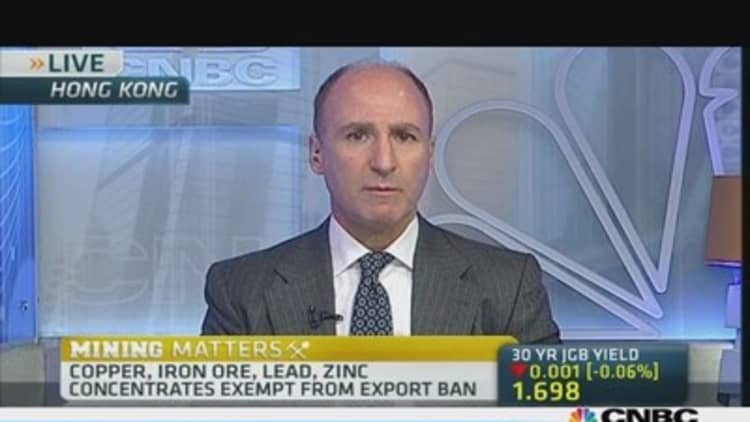Indonesia surprised markets on Wednesday by dishing out better-than-expected growth figures, raising the question whether the upbeat numbers are a mere flash in the pan.
Gross domestic product grew 5.7 percent in the fourth quarter from the same period a year earlier, beating the 5.3 percent consensus found in a Reuters poll of analysts. It marked a faster expansion than the 5.6 on-year percent rate recorded in the third quarter.
"Is the headline number an aberration in a moderating trend or has the economy really bottomed?" Robert Prior-Wandesforde of Credit Suisse wrote in a note. "Our take on the fundamentals would suggest the former is the more likely hypothesis."
(Read more: Indonesia braces for impact of mineral export ban)
According to Prior-Wandesforde, the surprising strength in exports – which grew 7.4 percent year-on-year in the quarter and was the key factor behind the strong GDP showing – was the result of mining companies bringing forward exports in anticipation of the ban on unprocessed mineral exports which went into partial effect in January.
The government put in place the controversial ban in the hope of boosting profits in its mineral sector by forcing miners to process their ore at home before export.

"Although the government eventually watered down the ban, officials from the main mining companies have been quoted as saying that confusion surrounding the government's regulatory regime and tax policy led them to stop exporting altogether in January," he said.
"Not only does this bode badly for the January external trade balance but is likely to mean that export growth slows in the first quarter," he added.
Credit Suisse also raised concerns that the Indonesian economy has not felt the full effects of the tightening policies unleashed by the Bank Indonesia (BI) last year.
(Read more: Asian governments to central banks: it's our mess, you fix it)
The central bank has hiked benchmark interest rates by 175 basis points since June in a bid to prop up its a battered currency, and ease its high inflation rate and a ballooning current account deficit.
"Bank Indonesia only started to raise rates in mid-2013 and statistical analysis suggests that it normally takes at least 9-12 months for the impact to be felt," Prior-Wandesforde wrote, adding that he is sticking to his 5 percent growth projection for 2014.

According to a note from Barclays, while the BI isn't expected to raise interest rates in its February meeting, a hike could come before the quarter is out.
"We continue to expect a 25 basis points rate hike in the first quarter to boost BI's credibility and increase real rates to help fund the current account deficit," said Barclays, who also expects Indonesia full year growth to come in at 5 percent.
But Wellian Wiranto of OCBC offers a more upbeat view, noting that private consumption, which grew 5.3 percent in the quarter from the year-ago period, was a sign the economy may be pursuing the "Goldilocks goal."
(Read more: 'Fragile Five' face low risk of full-fledged crisis: Roubini)
"The Q4 upside surprise in GDP shows that the underlying Indonesian economy still had a lot of juice, despite what was a rather tough environment," Wiranto wrote.
"The journey towards a not-too-hot, not-too-cold growth has just begun, but BI would not ratchet up rates just yet as it waits for the effects of last year's rate hike to kick in further," he added.
- By CNBC's Li Anne Wong. Follow her on Twitter at @LiAnneCNBC

